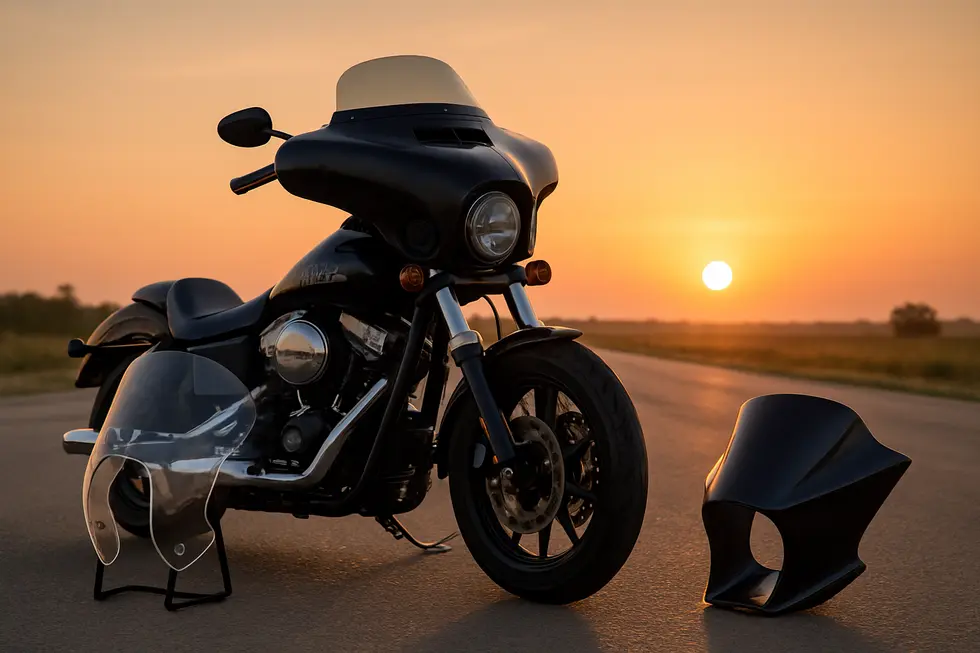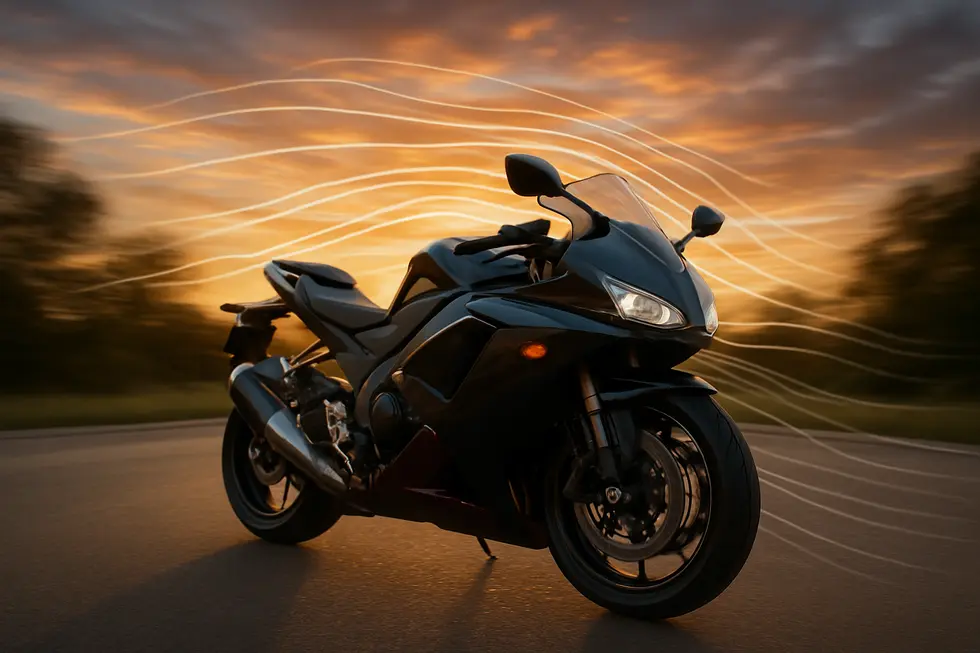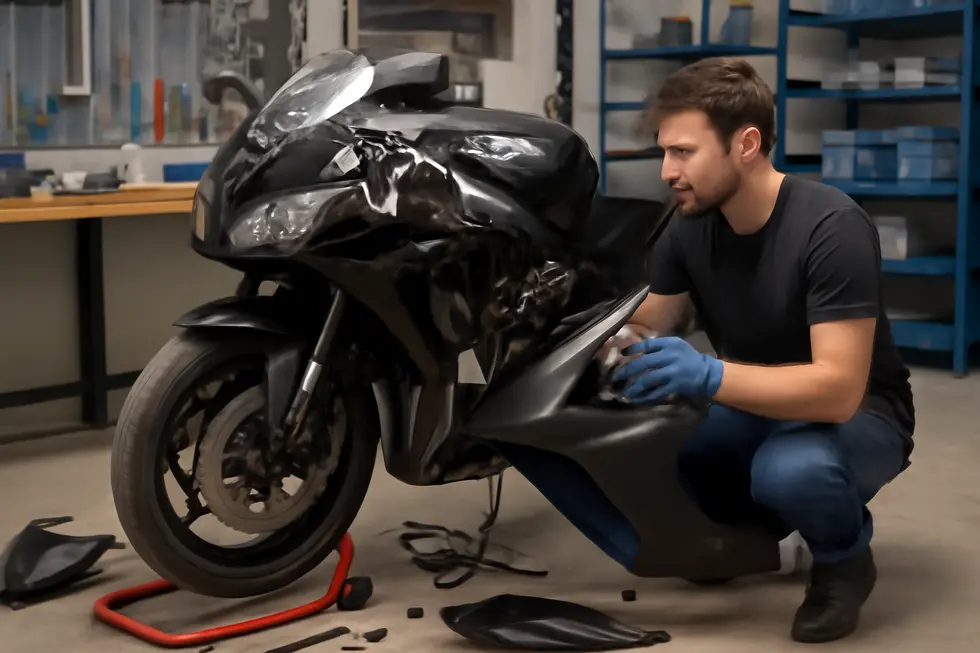Mastering Motorcycle Fairings: Types, Materials, and Benefits for Business Growth
August 20, 2025 | by summitfairings
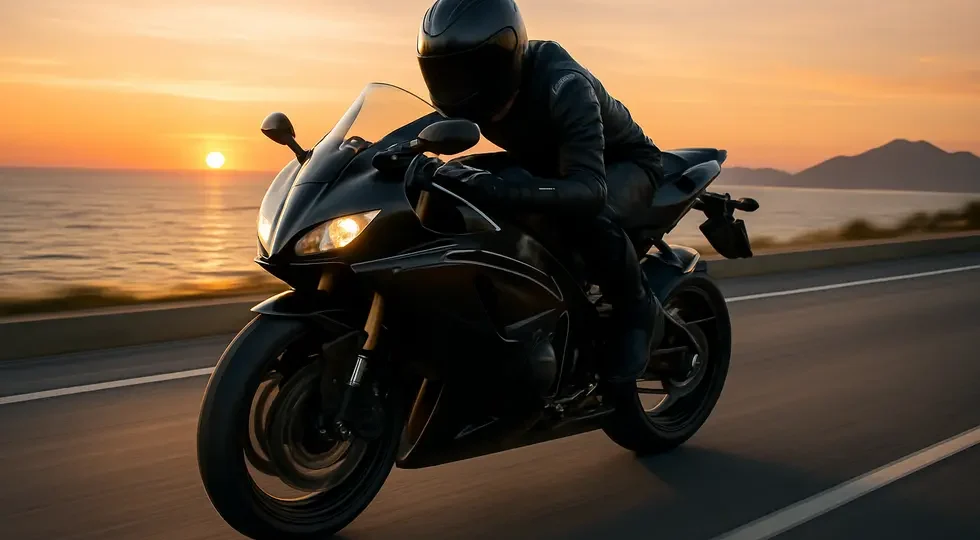
Introduction
Motorcycle fairings are more than just aesthetic enhancements; they are crucial components that impact a bike’s performance, rider protection, and overall appeal. For business owners in the motorcycle industry, understanding the nuances of various fairing styles, materials, and their functional benefits can unlock new avenues for product offerings, customer satisfaction, and market differentiation. This article delves deeply into the primary types of motorcycle fairings—half fairings, full race fairings, and complete kits—offering insight into their specific applications and market demands. The exploration continues by highlighting the role of advanced materials and aerodynamic design in manufacturing, crucial for maximizing performance and durability. Finally, the functional and aesthetic benefits of fairings, including cutting-edge integrated lighting innovations, are examined to illustrate how modern fairings can meet evolving rider needs and enhance business value. This comprehensive perspective equips motorcycle business owners with the knowledge to strategically select, market, and innovate within the fairing segment.
Tables of Contents
Chapter 1: Types of Fairing for Motorcycle: Half Fairings, Full Race Fairings, and Complete Kits
- Distinct Design and Functional Roles of Half, Full Race, and Complete Motorcycle Fairings
- Advanced Materials and Manufacturing Techniques Shaping Motorcycle Fairings
- Navigating Costs and Value: Economic Insights into Motorcycle Half, Full Race, and Complete Fairing Kits
- Choosing the Right Motorcycle Fairing: How Rider Priorities Shape Fairing Preferences and Usage
- Evolving Trends and Personalization in Motorcycle Fairings: Exploring Half, Full Race, and Complete Kits
Chapter 2: Materials and Aerodynamics in Fairing for Motorcycle Design
- How Material Choices Shape Aerodynamics and Performance in Motorcycle Fairings
- Streamlined Innovation: Aerodynamic Shaping and Materials Driving Motorcycle Fairing Performance
- Innovations in Lightweight Materials and Aerodynamic Precision Shaping Motorcycle Fairings
- Balancing Cost, Performance, and Practicality in Motorcycle Fairing Materials and Aerodynamics
- Enhancing Structural Integrity and Aerodynamic Performance Through Cutting-Edge Fairing Technologies
Chapter 3: Enhancing Motorcycle Performance and Comfort Through Aerodynamics and Design
- Streamlined Aerodynamics and Rider Comfort: The Dual Edge of Modern Motorcycle Fairings
- How Advanced Materials and Tailored Customization Enhance Motorcycle Fairings’ Performance and Visual Appeal
- Illuminating Performance: How Integrated Lighting Enhances Motorcycle Fairing Functionality and Style
- Crafting Visual Identity Through Motorcycle Fairings: Style, Aerodynamics, and Lighting Integration
- Cutting-Edge Innovations in Motorcycle Fairings: Winglets, Stealth Designs, and Integrated Lighting
Chapter 1: Types of Fairing for Motorcycle: Half Fairings, Full Race Fairings, and Complete Kits
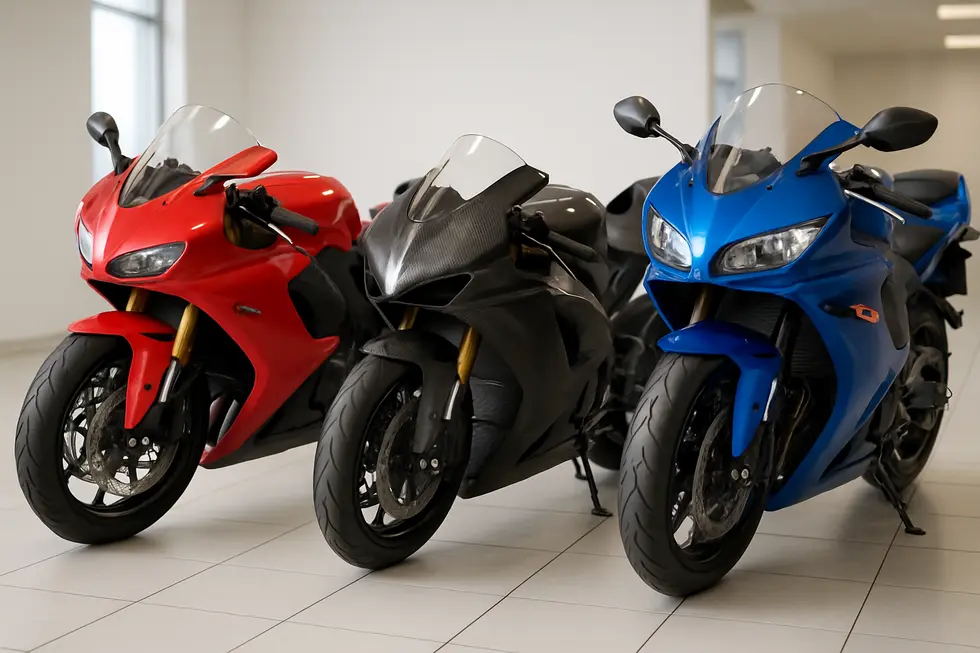
1. Distinct Design and Functional Roles of Half, Full Race, and Complete Motorcycle Fairings
Motorcycle fairings come in distinct forms, each designed with specific coverage, materials, and functional aims that cater to diverse riding styles and performance demands. Half fairings cover the bike’s upper front section—shielding the windshield, headlight, and handlebars—providing moderate aerodynamic advantages and ample wind protection for the rider’s torso. Crafted often from ABS plastic or fiberglass, they balance airflow management with lighter weight and easier engine access. This makes them ideal for touring and street riders who prioritize comfort and straightforward maintenance without sacrificing maneuverability.
In stark contrast, full race fairings envelop the motorcycle’s entire front and sides, extending coverage over the tank and tail, and wrapping nearly all exposed mechanical components. These are typically made from lightweight, rigid materials like carbon fiber or advanced composites designed to withstand racing stresses while minimizing weight. The result is maximum aerodynamic efficiency, improved rider stability at high speeds, and durable shielding for vulnerable parts during competitive track use. Their aggressive contours and full coverage are tailored for optimal airflow control and minimal drag.
Complete fairing kits offer the greatest versatility, sometimes combining elements of half, full, or quarter profiles to suit specific needs. Manufactured using a spectrum of materials—from durable OEM-grade injection-molded plastics to premium carbon fiber—these kits deliver comprehensive protection, enhanced aerodynamics, and broad customization potential. Riders benefit from improved fuel efficiency through drag reduction, substantial weather and debris defense, and the opportunity to personalize their bike’s appearance with integrated vents or specialty finishes.
These design and functional distinctions inform rider choice, framing half fairings as the practical option for comfort and moderate protection, full race fairings as the high-performance solution for aerodynamics and weight reduction, and complete kits as a customizable bridge addressing both utility and style. For those exploring detailed options and fitment, more insights are available at Explore the Best Motorcycle Fairings at Summit Fairings.
2. Advanced Materials and Manufacturing Techniques Shaping Motorcycle Fairings
Motorcycle fairings are crafted from a select range of materials chosen for their ability to balance weight, durability, and aerodynamic performance. The choice of material directly impacts the fairing’s function and the riding experience. High-performance full race fairings largely rely on carbon fiber composites due to their exceptional strength-to-weight ratio—approximately 40% lighter than aluminum—combined with impressive heat resistance up to 250°C. This enables riders to benefit from significant drag reduction, often around 15-20%, translating into superior speed and stability on the track. Carbon fiber also offers aesthetic versatility, allowing custom colors and weaves without sacrificing structural integrity.
In contrast, half fairings and many street-oriented complete kits tend to employ ABS plastic or fiberglass/polyester composites. ABS plastic has emerged as a popular choice because it delivers durable impact resistance, cost efficiency, and a precise OEM fit. These kits can include multi-layer paint finishes sealed with clear coats, enhancing both protection and visual appeal. Fiberglass/polyester remains favored in aftermarket racing components due to its lower cost and reasonable strength-to-weight ratio, though it is heavier and less heat tolerant compared to carbon fiber.
The manufacturing processes for these materials vary accordingly: carbon fiber fairings are typically molded under pressure and heat to unify resin and fiber layers, ensuring lightness and resilience. ABS plastic kits benefit from injection molding technology that allows exact replication of OEM contours, facilitating easy installation with pre-drilled holes and included mounting hardware.
These material and manufacturing advancements empower riders to select fairings tailored to their preferences—whether prioritizing race-grade aerodynamic efficiency and lightness or opting for street-ready durability and affordability. For more insights on high-quality options and installation ease, the exploration of affordable motorcycle fairings provides valuable guidance.
3. Navigating Costs and Value: Economic Insights into Motorcycle Half, Full Race, and Complete Fairing Kits
Economic factors play a pivotal role when selecting between half fairings, full race fairings, and complete fairing kits. Pricing largely hinges on materials, manufacturing intricacies, intended application, and brand reputation. Half fairings, covering only the upper front, strike a balance between affordability and functional wind protection. Their lower material and production complexity typically make them the most budget-friendly option, appealing to street riders who desire style without overspending.
Full race fairings, crafted for maximum aerodynamic advantage and weight reduction, command a higher price due to premium materials such as carbon fiber and specialized composites. These components cater primarily to racers who prioritize performance gains, justifying steeper upfront investments with potential lap time improvements derived from reduced drag and weight.
Complete fairing kits, which include multiple body panels and often feature OEM-grade fitment or custom finishes, fall in a mid-to-high price range. They offer convenience through comprehensive coverage and often come pre-drilled and ready to install, providing value to enthusiasts seeking a polished, factory-like appearance or those outfitting their bikes comprehensively.
The market reflects these distinctions, with carbon fiber race fairings sometimes surprisingly affordable at entry levels, while premium options trend significantly higher. Additional expenses may arise from custom paint jobs or accessory upgrades, influencing the final cost. Buyers weighing economic decisions must consider the trade-off between the durability and ease of OEM plastic kits versus the weight advantages and fragility of race-grade composites.
Ultimately, the balance between cost, performance, and aesthetic preference defines purchasing choices. Street riders typically lean toward mid-priced, durable kits with moderate aerodynamic benefit, while dedicated racers accept higher expense for lightweight, precision-engineered solutions. The tiered pricing approach effectively accommodates both budget-conscious consumers and high-performance enthusiasts.
For those interested in exploring a broad spectrum of options that merge cost and style effectively, visiting Summit Fairings’ blog provides helpful perspectives and product information.
(Source: Yamaha R1 2024 Fairing Market Overview)
4. Choosing the Right Motorcycle Fairing: How Rider Priorities Shape Fairing Preferences and Usage
Motorcycle riders’ preferences for fairings hinge largely on their riding style, performance goals, and aesthetic tastes. Half fairings tend to attract touring riders and street enthusiasts who value moderate wind protection combined with ease of maintenance. These fairings cover the bike’s upper front, shielding the rider’s torso from wind fatigue while maintaining good visibility. Lightweight and often fashioned from ABS plastic, half fairings offer a classic or cruiser style that complements mid-level performance bikes and touring motorcycles. Their relatively minimal coverage also preserves maneuverability and accessibility for routine upkeep, making them ideal for longer rides where comfort matters.
In contrast, full race fairings are the choice of sportbike riders who prioritize peak aerodynamic efficiency and reduced weight. Crafted from advanced materials like carbon fiber, these fairings encapsulate the entire front and sides of a motorcycle, drastically reducing drag at high speeds. This design is tailored for track days and aggressive riding, prioritizing stability and top-end velocity over comfort or maintenance convenience. The sleek, fully enclosed form enhances not only performance but also rider protection against debris and wind pressure during rapid acceleration.
Complete kits offer a versatile middle ground that appeals to both racers and customizers seeking comprehensive coverage and cohesive styling. These kits often include multiple panels—such as belly pans and headlight assemblies—crafted from durable ABS plastic or premium carbon fiber. This flexibility allows riders to combine aerodynamic gains with personalized visual impact, delivering protection from elements while achieving a unified aesthetic across the motorcycle’s profile. Whether used for street customization or competitive racing, complete kits balance form and function impressively.
For instance, someone upgrading a Yamaha XSR might opt for half-fairing accessories to improve street comfort and cruising style, while another rider could select a carbon-fiber full race kit to enhance track capabilities. This dynamic reflects ongoing market trends that emphasize not only materials innovation but also tailoring fairing choices to distinct riding environments and goals.
Explore the variety of options and rider-focused insights through resources like the explore the best motorcycle fairings at Summit Fairings.
5. Evolving Trends and Personalization in Motorcycle Fairings: Exploring Half, Full Race, and Complete Kits
Customization and Aftermarket Trends in Motorcycle Fairings have significantly expanded beyond mere aerodynamic improvement. Riders today seek parts that seamlessly blend enhanced performance, rider comfort, and distinct personal style. Half fairings typically appeal to those favoring a minimalist approach—covering the upper front to reduce wind buffeting while maintaining a classic aesthetic. Advances in impact-resistant ABS plastic allow manufacturers to offer sleek semi-fairings that balance protection with lightweight construction, catering to riders who appreciate subtle wind management without sacrificing the iconic motorcycle silhouette.
On the other end, full race fairings focus on delivering maximum aerodynamic efficiency for track and high-speed riding. Modern aftermarket options employ injection molding techniques using durable ABS plastic that ensures precision fit and lightweight strength. These kits often feature multi-layer paint finishes with clear coats that resist weathering and chipping. Moreover, customization has evolved beyond solid colors, giving riders the option to apply vibrant racing-inspired graphics or create personalized schemes that reflect individual tastes or team loyalties. The inclusion of pre-drilled mounting points and bolt kits simplifies installation, encouraging DIY enthusiasts to upgrade their bikes without professional assistance.
Complete fairing kits merge functionality and style by providing all necessary components tailored to specific motorcycle models, including front cowls, side panels, and tail sections. The ability to customize color palettes and decals within these kits allows riders to achieve a full transformation that enhances both appearance and aerodynamic performance. Additional accessories, such as free windscreens or heat shields, add practical value and comfort.
These trends demonstrate a shift toward comprehensive customization that caters to diverse rider preferences while preserving the core benefits of fairings. Riders can thus optimize their motorcycles for improved wind management, increased speed potential, and a personalized look that stands out on streets or tracks alike.
For those interested in exploring a wide array of affordable, style-conscious options, there are extensive selections available at Summit Fairings.
Chapter 2: Materials and Aerodynamics in Fairing for Motorcycle Design
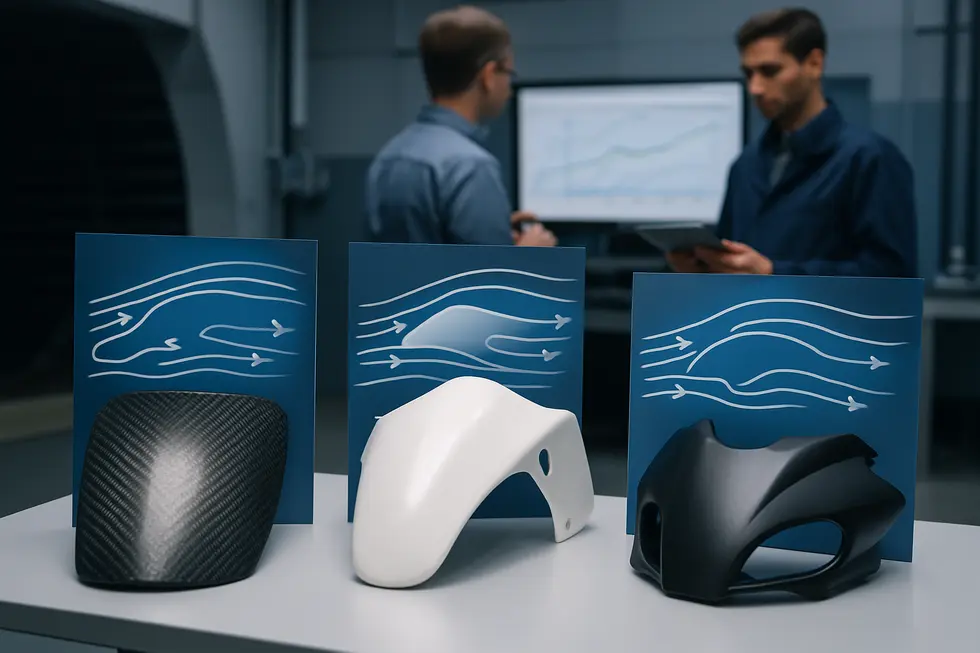
1. How Material Choices Shape Aerodynamics and Performance in Motorcycle Fairings
The materials chosen for motorcycle fairings profoundly influence both aerodynamic efficiency and overall bike performance. By blending physical properties like weight, strength, and flexibility with aerodynamic precision, manufacturers optimize fairings to reduce drag, enhance rider stability, and protect mechanical components.
Lightweight composites such as carbon fiber and fiberglass dominate, each bringing unique advantages. Carbon fiber offers an exceptional strength-to-weight ratio, enabling the construction of full-coverage race fairings that dramatically improve speed and durability without adding bulk. Its precision molding allows intricate aerodynamic shapes that smooth airflow and reduce turbulence, essential for high-speed racing motorcycles.
Fiberglass composites strike a balance between durability and impact resistance. Their shells disperse energy during crashes, enhancing safety while maintaining moderate weight. This makes fiberglass a popular choice for protective street fairings that require longevity and some flexibility.
ABS plastic, commonly used in aftermarket kits, combines lightness—about 20% lighter than traditional metal panels—with weather and UV resistance. Its ease of molding supports complex aerodynamic forms that can reduce wind drag by up to 25%, boosting fuel efficiency and handling. Moreover, ABS is resilient enough for road use, offering a practical balance of performance and cost.
The ability to tailor fairings precisely to each motorcycle’s geometry depends heavily on the selected material’s moldability and structural integrity. Smooth, contoured surfaces reduce airflow separation, leading to greater high-speed stability. For example, batwing-style ABS kits show how material and design merge to optimize aerodynamics while preserving manageable weight.
Ultimately, the synergy between material characteristics and aerodynamic design dictates the fairing’s effectiveness. Choosing advanced composites over heavier metals enhances not just top speed and fuel economy but also rider comfort and crash resilience, making material selection a key factor in modern motorcycle fairing design. To explore a wide variety of these options, see more about affordable motorcycle fairings at Summit Fairings.
For deeper insight into how materials affect aerodynamics in racing contexts, the video Race Motorcycle Fairing Materials & Aerodynamics offers detailed analysis and examples.
2. Streamlined Innovation: Aerodynamic Shaping and Materials Driving Motorcycle Fairing Performance
Motorcycle fairings embody a delicate balance of aerodynamic refinement and material innovation, crafted to minimize drag and boost stability at high speeds. The core design philosophy centers on creating smooth, continuous lines that channel airflow efficiently, reducing turbulent wake and pressure imbalances that compromise rider control and speed. Ingenious features like integrated winglets generate downforce, enhancing traction during aggressive cornering and high-velocity runs. These winglets, often sculpted to also serve as air outlets, assist in heat management by directing airflow toward critical engine components, demonstrating an elegant fusion of form and function.
The precise shaping of fairings also involves positioning leading edges and side panels to mitigate the destabilizing effects of crosswinds and sudden directional changes. Manufacturers conceal functional elements like oil coolers and intakes within streamlined contours, preserving aerodynamic cleanliness without sacrificing essential cooling. Aftermarket aerodynamic accessories, such as spoiler wings and side deflectors, further stabilize handling by controlling airflow around the rider and chassis, reducing wind buffeting and enhancing comfort during sustained high speeds.
Material choices complement design objectives by employing lightweight composites—carbon fiber and fiberglass being predominant—that maintain structural strength while keeping weight low. This choice directly impacts maneuverability, acceleration, and fuel efficiency. The iterative refinement of these designs often leverages computational fluid dynamics (CFD) alongside wind tunnel testing to meticulously analyze drag, lift, and airflow patterns. For example, extensive helmet shape optimization experiments underscore how incremental changes significantly improve aerodynamic performance.
Beyond just aerodynamics, the integrated design approach extends to ancillary components like battery covers, crafted to harmonize with airflow paths, further reducing drag. This holistic attention to detail underscores that effective motorcycle fairings combine cutting-edge material technology with aerodynamic innovation to enhance speed, safety, and rider experience seamlessly.
Explore these in-depth design insights and aerodynamic innovations in greater detail at Explore the Best Motorcycle Fairings at Summit Fairings.
For a practical example of aerodynamic winglet application, Ducati’s Panigale V4 demonstrates how targeted downforce generation improves stability and cooling simultaneously Ducati Panigale V4 aerodynamic winglets and fairing design.
3. Innovations in Lightweight Materials and Aerodynamic Precision Shaping Motorcycle Fairings
Advancements in materials and aerodynamic design have revolutionized motorcycle fairings, achieving new levels of performance, durability, and rider comfort. Modern fairings blend cutting-edge composites like carbon fiber and ABS plastic, striking a fine balance between strength, flexibility, and weight reduction. For instance, the use of injection-molded ABS provides superior impact resistance and flexibility compared to conventional plastics, enhancing both durability and rider safety without adding unnecessary bulk. This has led to innovative hybrid approaches where costly carbon fiber reinforces critical frontal sections, while ABS supports rear areas, offering optimized performance at manageable costs. Simultaneously, there is a notable shift toward sustainability, with recycled composite materials gaining traction. Industry experts predict that by 2030, nearly a third of fairings will integrate eco-friendly, recycled components, underscoring a commitment to environmental responsibility alongside technical advancements.
Aerodynamic improvements owe much to sophisticated tools like computational fluid dynamics (CFD) and wind tunnel testing, allowing designers to sculpt fairings that minimize drag and increase downforce. These technologies ensure smoother airflow, which not only elevates top speeds but also bolsters rider stability and comfort during extended rides. Collaboration with MotoGP aerodynamic specialists has transferred race-level innovations into street-legal motorcycles, enabling the creation of fairings that harmonize sleek styling with functional airflow management. Iconic designs, such as Batwing-style fairings on touring motorcycles, exemplify this marriage of classic aesthetics and modern aerodynamic refinement.
Beyond performance, the marketplace values customization and emerging smart technologies. Popular finishes range from matte and gloss blacks to vibrant neon shades, reflecting the rider’s personal expression. Meanwhile, forecasts indicate that half of new fairings will adopt IoT features by 2030, integrating sensors and connectivity that further enhance safety and convenience.
Taken together, these technological strides not only boost motorcycle performance but also enrich the riding experience by combining advanced materials, precise aerodynamic shaping, and evolving smart functionality. This dynamic evolution continuously reshapes the role of fairings in motorcycle design. For further insights on quality and fitment in aftermarket fairings, exploring resources like this guide on affordable motorcycle fairings can be invaluable.
Learn more about aerodynamic innovation on street motorcycles here: https://livingwithgravity.com/red-dot-if-award-winning-new-panigale-v4-ducatis-design-mastery/
4. Balancing Cost, Performance, and Practicality in Motorcycle Fairing Materials and Aerodynamics
Selecting materials for motorcycle fairings requires a delicate balance between cost, weight, durability, and aerodynamic efficiency. Fiberglass and ABS plastic dominate the street motorcycle market for their affordability and sufficient strength. These materials enable manufacturers to produce fairings that protect riders and components while keeping costs manageable. ABS plastic’s ease of molding and repairability further contribute to practical maintenance and aftermarket customization options.
Conversely, carbon fiber stands out in racing environments where minimal weight and maximum strength are paramount. Its superior strength-to-weight ratio enhances both handling and speed but comes at a significantly higher price, making it less viable for everyday street use. Innovations in sustainable materials, such as bio-based polycarbonate resins, offer promising environmental benefits, although they currently add complexity and cost to fairing production.
Aerodynamic design deeply influences fairing material choice as well. Full race fairings crafted from lightweight composites optimize airflow and reduce drag to improve top speeds and rider stability. Partial or half fairings, often made from plastics, provide moderate aerodynamic gains suited to street riding without sacrificing ease of repair.
Practicality also demands attention to fitment precision, as model-specific fairings ensure proper aerodynamic function and secure installation, which can increase production costs. Suspension and chassis tuning harmonize with aerodynamic features to maintain stability and comfort, underscoring that material choice alone is not enough.
In sum, economical materials like ABS and fiberglass balance durability and aerodynamic benefit for mass-market motorcycles. High-performance setups invest in advanced composites to prioritize speed and rider protection. The interplay of these factors forms the backbone of effective and practical motorcycle fairing design.
For deeper insights on high-quality, affordable fairings suitable for street motorcycles, the resource your ultimate source for affordable motorcycle fairings provides valuable guidance.
External Reference: Motorcycle fairing materials and aerodynamics overview
5. Enhancing Structural Integrity and Aerodynamic Performance Through Cutting-Edge Fairing Technologies
Enhancing Structural Integrity and Aerodynamic Performance Through Cutting-Edge Fairing Technologies
Motorcycle fairings are no longer mere aesthetic additions; they represent a sophisticated fusion of engineering and materials science aimed at improving both structural stability and aerodynamic efficiency. At the core of this evolution lies the strategic selection of lightweight yet incredibly strong materials like carbon fiber composites, which offer an exceptional stiffness-to-weight ratio. By minimizing unsprung weight, these materials preserve the motorcycle’s agility while enhancing chassis rigidity, allowing for sharper handling and more precise rider feedback. Furthermore, some modern designs integrate the engine as a stressed frame member, tightening structural cohesion and further reducing overall bike mass.
Aerodynamic advancement is achieved through meticulous computational fluid dynamics analyses and wind tunnel testing, which refine the fairing’s shape to drastically reduce drag and control lift forces. This scientific approach not only boosts top speeds but also stabilizes the motorcycle during high-velocity maneuvers. The incorporation of aerodynamic features such as winglets and downforce-generating mirrors fine-tunes airflow, enhancing grip and balance without compromising rider protection. These dual-function components reflect a new generation of design that simultaneously safeguards and streamlines the motorcycle.
Beyond performance gains, durability and ease of assembly remain priorities. Fairings constructed from precision-molded ABS plastics or carbon composites endure environmental exposure and operational stresses without degradation. This ensures sustained aerodynamic properties and structural integrity over time. The end result is a finely balanced synthesis of form and function, where each design element optimizes mechanical strength and airflow management to elevate speed, control, and safety.
For riders seeking to explore a variety of durable and precisely crafted options, extensive selections of well-engineered fairings are available, catering to diverse performance needs and styles. More details can be found at Explore the Best Motorcycle Fairings at Summit Fairings.
An external resource outlining aerodynamic design principles can be referenced here: https://en.wikipedia.org/wiki/Aerodynamics
Chapter 3: Enhancing Motorcycle Performance and Comfort Through Aerodynamics and Design
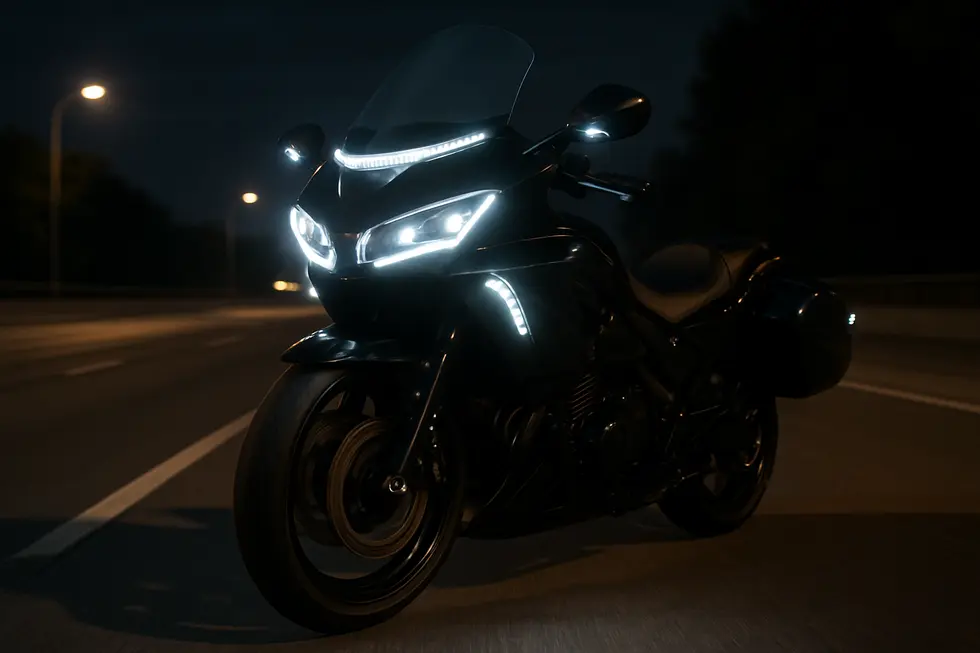
1. Streamlined Aerodynamics and Rider Comfort: The Dual Edge of Modern Motorcycle Fairings
Motorcycle fairings play a pivotal role in combining aerodynamic efficiency with rider comfort, significantly elevating both performance and the riding experience. By shaping the airflow around the motorcycle, fairings reduce air resistance and turbulence, allowing motorcycles to achieve greater top speeds with enhanced stability. This streamlined design not only improves handling but also introduces downforce elements—such as integrated winglets—that stabilize dynamics during aggressive riding or high-speed racing scenarios. A prime example lies in advanced fairing designs that incorporate these aerodynamic features while simultaneously improving cooling efficiency, ensuring engine performance remains optimal.
Beyond pure performance gains, fairings create a protective envelope for the rider. Windshields and contoured panels minimize wind buffeting, decreasing fatigue and enhancing endurance during long rides. Side winds are better managed, improving control during lane changes or turns. This “bubble” effect also buffers riders from debris and weather, quietly blending safety with comfort without sacrificing agility.
Aesthetically, modern fairings strike a balance between aggressive aerodynamic shapes and timeless design cues. While some integrated aerodynamic components add a radical, performance-focused appearance that can polarize opinions, this balance elevates the bike’s visual appeal without compromising its street presence. Meanwhile, innovation extends to lighting elements, where seamlessly integrated headlight assemblies crafted from lightweight materials maintain aerodynamic purity and add to the overall sleek profile. These advancements marry form and function, enhancing visibility while preserving the motorcycle’s refined silhouette.
Together, these features demonstrate how fairings serve as fundamental elements that enrich both the technical capabilities and the rider’s connection to the motorcycle. For riders seeking a harmonious blend of speed, comfort, and style, exploring premium options can reveal how aerodynamic design transforms everyday rides and track performance alike. Learn more about innovative fairing choices and their impact on riding experience at Explore the best motorcycle fairings at Summit Fairings.
2. How Advanced Materials and Tailored Customization Enhance Motorcycle Fairings’ Performance and Visual Appeal
Motorcycle fairings leverage advanced materials and thoughtful customization to significantly boost both performance and aesthetics. Among these materials, carbon fiber stands out for its exceptional strength-to-weight ratio, favored in high-performance and racing motorcycles where minimizing weight without sacrificing durability is vital. Fiberglass and ABS plastic remain popular choices, especially ABS, due to its durability, excellent fitment with OEM specifications, and ease of finishing—ideal for aftermarket customization that balances resilience with affordability.
Customization goes beyond mere appearance; it actively shapes aerodynamic efficiency and rider comfort. Riders frequently personalize fairings by applying unique paint schemes, matte or glossy finishes, and decals that enhance visual identity, drawing inspiration from iconic motorcycle designs. Ergonomic upgrades such as modular handlebar covers or footpegs can be integrated, improving control and reducing fatigue on longer rides. Performance-driven customizations include reinforced, racing-grade fairings that streamline airflow and provide greater stability under high-speed conditions.
The functional benefits of combining carefully selected materials with tailored modifications are substantial. These fairings manage airflow to reduce drag and enhance top-end speed. Innovations like aerodynamic winglets improve stability by generating downforce without compromising agility or handling, vital for riders navigating variable wind conditions. Additionally, well-designed fairings help optimize cooling by channeling air efficiently over radiators and engine components, maintaining performance even in demanding environments.
Aesthetically, durable materials allow for vibrant, long-lasting finishes, ensuring that a motorcycle’s visual presence remains striking over time. Modern trends integrate lighting innovations directly into the fairing design, such as LED headlights seamlessly embedded within aerodynamic headlight shells crafted from composites or carbon fiber. This integration reduces protrusions that increase drag and simultaneously improves illumination quality, allowing enhanced visibility with minimal impact on style. Such lighting solutions embody the fusion of form and function, elevating safety while complementing the motorcycle’s aesthetic appeal.
The synergy of material science and customization empowers riders to optimize their fairings for both rigorous performance demands and personalized style—a balance that defines modern motorcycle design. For further insights on customization and material options, explore custom motorcycle fairings and styles.
External reference: Carbonvani Ducati Panigale Fairing
3. Illuminating Performance: How Integrated Lighting Enhances Motorcycle Fairing Functionality and Style
Integrated lighting within motorcycle fairings transcends mere visibility upgrades; it represents a harmonious fusion of safety, aerodynamics, and design elegance that elevates both rider experience and machine identity. These lighting innovations—ranging from daytime running lights (DRLs) to switchback LEDs and flush-mount turn signals—are meticulously incorporated into fairings to maintain sleek aerodynamic profiles while dramatically improving on-road visibility.
Daytime running lights operate at a subdued intensity, making motorcycles more noticeable during daylight without overwhelming other drivers. Their strategic placement within fairings ensures they coexist seamlessly with aerodynamic contours, preserving airflow and stability at high speeds. Switchback LED turn signals cleverly alternate between white and amber light, offering a distinct communication method that enhances signaling clarity in busy traffic conditions. These signals’ integration into the fairing’s smooth surfaces prevents airflow disruption and potential drag increase.
Flush-mount LEDs further the aesthetic by embedding lighting fixtures almost seamlessly into the fairing’s bodywork, maintaining clean lines crucial to performance and visual appeal. This close integration reduces protrusions that might otherwise cause instability or hinder speed, consolidating form and function.
Beyond illumination, integrated lighting contributes to a motorcycle’s character, reinforcing aggressive, modern designs found on high-performance sportbikes. Elements like aerodynamic winglets and streamlined side panels are visually complemented by subtle yet striking lighting effects, which conceal mechanical components and enhance the bike’s refined silhouette. Accessories inspired by aerodynamic design principles enhance this synergy, merging style with practical downforce improvements.
These advances in integrated lighting highlight how fairings have evolved into multi-functional components that prioritize rider safety, aerodynamic efficiency, and striking appearance. For those interested in exploring versatile and innovative motorcycle fairings that embrace these technologies, Summit Fairings offers a comprehensive resource to discover tailored solutions.
Learn more about the role of cutting-edge lighting in motorcycle fairing design at EagleLights’ guide on switchback turn signals.
4. Crafting Visual Identity Through Motorcycle Fairings: Style, Aerodynamics, and Lighting Integration
Motorcycle fairings extend far beyond mere functionality; they are pivotal in shaping a bike’s distinct visual identity. Through sculpted shapes and carefully selected materials—ranging from polished chrome to faux carbon fiber finishes—fairings transform motorcycles into striking statements of personal style and engineering prowess. Iconic models seamlessly merge design heritage with modern technology, featuring aerodynamic contours and integrated components like winglets that not only enhance performance but create a dynamic, fluid silhouette. This union elevates the motorcycle from a mode of transport to a design icon recognized in prestigious awards.
Customization amplifies this aesthetic impact, with modular fairing parts that allow riders to modify ergonomics and style effortlessly. Riders can express individuality by choosing colors, finishes, and shapes that resonate with their personality while maintaining or enhancing aerodynamic efficiency. The strategic integration of lighting technologies within fairings exemplifies this marriage of form and function. Sleek LED arrays and signature lighting signatures are embedded in headlight assemblies and windshield trims, enhancing safety without sacrificing the streamlined flow.
These lighting innovations not only improve road presence but also amplify the motorcycle’s aggressive yet elegant appeal, contributing to a cohesive design narrative. Fairings thus become an artistic framework that houses both cutting-edge aerodynamic engineering and sophisticated lighting solutions, creating machines that captivate visually while excelling in high-speed stability and rider comfort. This holistic approach enables motorcycles to stand out as both high-performance tools and aesthetic masterpieces.
For riders seeking refined style along with functional excellence, exploring the diverse options in fairing customization offers unparalleled possibilities. More on these choices and their impact can be found by exploring the range of fairings available from specialty suppliers, as detailed in explore the best motorcycle fairings at Summit Fairings.
Further design insights are found in analyses of models like the Ducati Panigale V4, where innovation in fairing design and integrated LED lighting set benchmarks in the industry.
5. Cutting-Edge Innovations in Motorcycle Fairings: Winglets, Stealth Designs, and Integrated Lighting
Motorcycle fairings have evolved far beyond simple aerodynamic shells, merging advanced materials and technology to redefine both performance and style. Modern fairings utilize lightweight yet robust materials like carbon fiber and ABS plastic, striking a perfect balance between durability and weight reduction. This innovation materially improves speed and stability by minimizing drag, crucial for riders seeking precision handling and enhanced cornering at high velocities.
One of the most notable technological leaps is the integration of winglets—small aerodynamic fins seamlessly incorporated into sportbike fairings. These winglets generate downforce, anchoring the motorcycle firmly to the road during aggressive maneuvers and high-speed turns. By increasing grip and stability without adding significant weight or bulk, winglets exemplify how aerodynamic engineering directly enhances rider control and safety.
Complementing aerodynamic gains are stealth components, which emphasize sleek, low-profile designs that preserve an aggressive visual impact without the usual bulk of traditional fairings. Inspired by military stealth technology, these components reduce visual clutter, producing a streamlined silhouette that appeals to riders focused on sharp aesthetics coupled with functionality.
Integrated lighting innovations also advance both safety and aesthetics. LED headlights, underglow systems, and auxiliary lights hidden elegantly within the fairing provide enhanced illumination while maintaining a cohesive design. These lighting features not only improve nighttime visibility but also allow for customizable color and pattern effects that elevate the motorcycle’s visual presence on the road.
Custom finishes and 3D-printed parts further extend personalization possibilities. Multi-layer UV-resistant paints and gradient color schemes protect the fairing and enrich its visual appeal, allowing riders to express individuality without sacrificing performance. Together, these advancements highlight how contemporary fairings deliver a sophisticated synthesis of aerodynamic refinement, rider safety, and bespoke styling.
For those interested in exploring diverse designs that combine functionality with high customization, the collection of motorcycle fairings available offers a comprehensive source for innovative shapes and integrated technologies. Discover affordable motorcycle fairings at Summit Fairings.
Learn more about cutting-edge automotive lighting and material technology from specialized industry resources.
Final thoughts
Motorcycle fairings represent a critical intersection of form and function, blending aerodynamic engineering with rider comfort and visual appeal. For business owners, appreciating the distinctions among half fairings, full race fairings, and complete kits establishes a foundation for targeted product offerings that align with varied customer needs. The careful selection of materials like carbon fiber, fiberglass, and ABS plastics further empowers manufacturers and retailers to innovate with durable, lightweight designs that directly influence performance and cost-effectiveness. Moreover, the evolving functional and aesthetic benefits—including integrated lighting technologies—create additional value propositions that resonate with both daily riders and performance enthusiasts. This holistic understanding positions motorcycle businesses to enhance customer satisfaction, boost sales, and lead in a competitive marketplace where quality and style converge. Investing in superior fairing solutions ultimately drives growth and brand loyalty in an evolving industry.
Ready to elevate your ride? Summit Fairings delivers premium, custom-fit fairings that blend style and durability. Whether you’re chasing speed or turning heads, we’ve got your bike covered. Don’t wait—transform your machine today. Click, customize, and ride with confidence. Your perfect fairing is just a few clicks away. Act now!
About us
We are one of the leading motorcycle fairing export sites, offering over 3,000 styles across nearly all motorcycle models. By buying from summitfairings.com, you pay 10-40% less than other sites without compromising quality. We pride ourselves on prompt and reliable customer service—if you have any questions, expect an answer within six hours. Elevate your motorcycle’s performance and look with Summit Fairings’ extensive collection and expert support.
RELATED POSTS
View all

